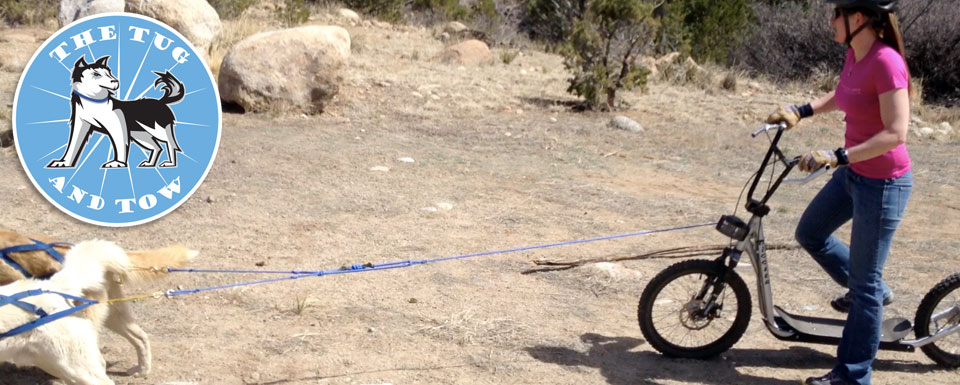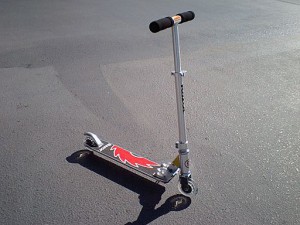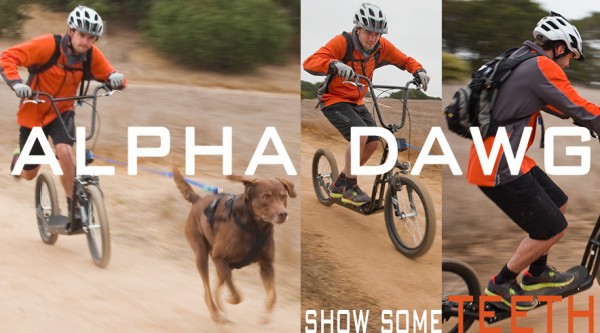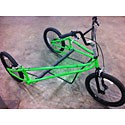I was surfing the web one day for some dog related topics. I don’t remember what I was looking for, but in retrospect, what I found has changed the rest of my life!
I suddenly came upon a picture unlike any I had ever seen before.
What I was viewing, was one dog in harness, pulling a two wheeled vehicle, with the driver/rider in standing position.
The scene suggested some type of sport or sporting event.
A bell went off in my head and I wondered “could this be a mobility option for me”?
I really wanted to understand what I was seeing and if there was some application to my life and situation.
My investigation took place in bits and pieces over time, but I’ll try and put it in some historical order as best I can.
When I looked into it, this is what I found.
The vehicle I saw was originally called a “Mountain Scooter”.
I was able to find out that It was originally designed in the 1990s as a small offshoot of the serious mountain bike industry.
This device was intended to ride down mountain bike trails that were located on the ski slopes of operating ski areas and resorts.
This would be part of a ski area’s off season and summer activities that have greatly developed in recent years.
Mountain bikes and now these mountain scooters could be rented at the ski area and taken up the ski lifts to access the trails where they started higher up the mountain.
Notice there would be no grueling climb up the mountain, only gravity helping you get down.
As I looked into the technical side of these scooters, it became clear that they were considered to be much safer than mountain bikes.
Now why would that be? It all has to do with the “center of gravity”.
When riding a mountain bike or most any bike, the center of gravity is centered around the seat where much of the rider’s weight is.
Because the bike seat and center of gravity is so far from ground level it’s not difficult for the rider to be catapulted over the handle bars in many types of collisions. (Simple explanation.)
When riding a mountain scooter, the center of gravity is only a few inches above ground level.
This is because the rider is standing on a platform, as there is no seat.
The weight of the rider is almost totally on the platform which places the center of gravity at platform level, a few inches above the ground.
This makes it very difficult for the rider to be thrown over the handle bars..
In addition, the position of a bike rider puts the head in a line which easily leads over the handlebars.
A mountain scooter rider in the standing position does not have their head in such a line.
Later on I was able to talk with people who had seen these in action in ski areas.
i realize that the term scooter is possibly confusing to some readers.
As I have mentioned this in conversation, many people associate the term with the small, hard wheeled scooters that kids of many ages can ride on.
If you’ve noticed these scooters, you might have seen that the small wheels can be derailed by even a large crack in the sidewalk.
They also are not suitable for an unpaved surface.
This Handles Off Road Slopes!
I’m describing a scooter that can navigate down dirt trails on a mountainside, that you know are going to have rocks, tree roots and probably some holes.
So what’s the difference? How does a mountain scooter handle all that?
It is a scooter in the sense that the rider stands on a platform, with no seat. It has no pedals, gears or chains and is powered by gravity downhill, or pushed by the rider with one or both feet on the ground.
However, unlike what you might think from the word “scooter” it typically has 20″ BMX type tires and wheels with considerable ground clearance.
It is built to be sturdy enough for the ski slopes and has good brakes (Thank goodness.).
Some models also have some suspension features for a softer ride.
To give a sense of scale, they approach or equal six feet in length, including both wheels.
Quite different from the kid’s “Razor” scooter eh?
Apparently, during the early 2000s, someone had their dog pull them on it, and a new sport started to develop.
Generally it is used on unpaved trails as being best for the dogs and for this sport was now called a dog scooter.
Later on I also found other styles of dog scooter that were two or even three wheel based for various dog and balance situations.
Boy was I intrigued by all this!
Earlier in life I had spent much enjoyable time “off road” or “in the bush”.
Between hiking, some camping, exploring and the like, it was one of my favorite activities.
I had not been able to do these things for many years and figured it was all behind me.
When I acquired my handicap, it left me with impaired mobility.
Much of this story is about Kuma and Balto learning a certain system of dog walking just so I would be able to walk them.
Was a dog scooter a way that I could get around in the off road environment?
I wasn’t interested in sport so much as basic off road transportation.
Kuma and Balto did a fine job of helping me walk further than I could on my own, but could they learn to pull me on a dog scooter?
Would this be a real game changer for all of us? I sure wanted to find out!
![]()



